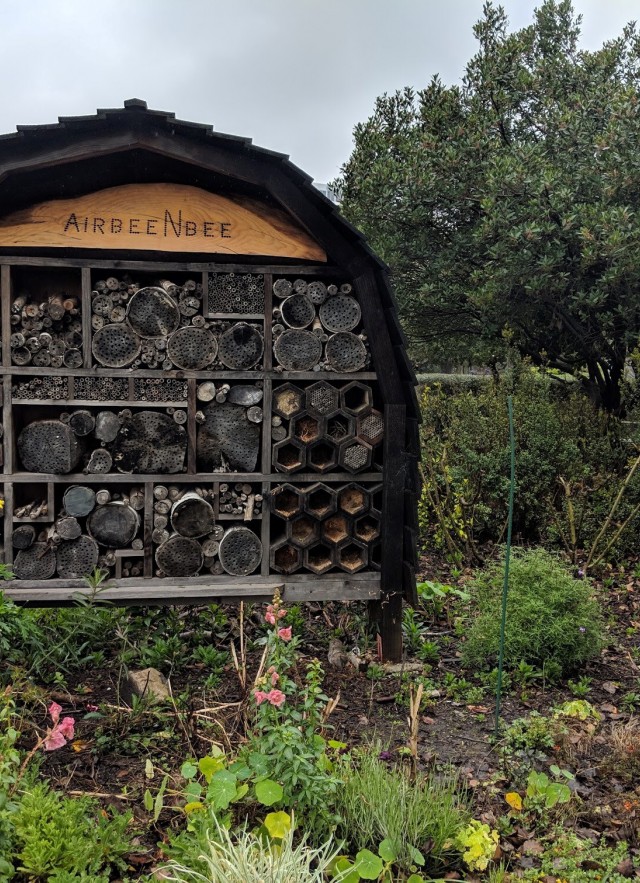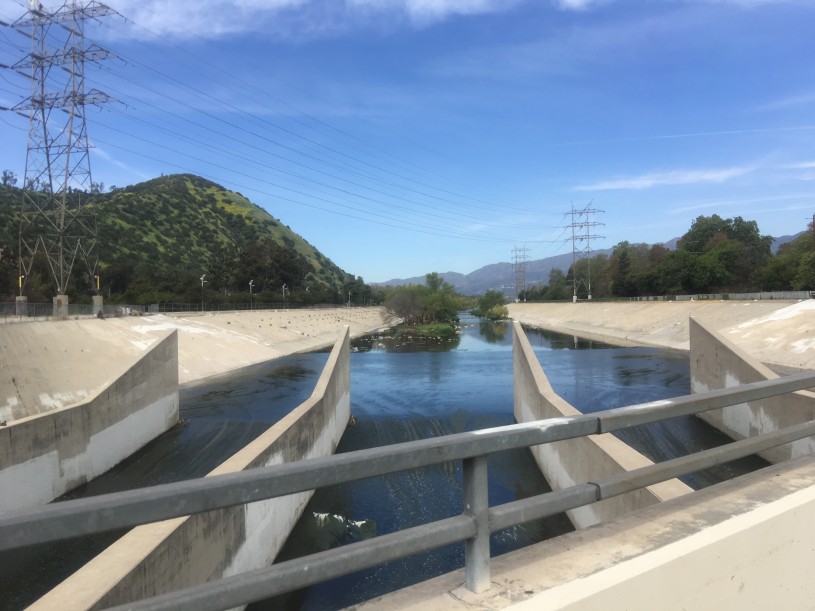Voices of L.A. Nature: Interview with Kat Superfisky
Welcome to our new series, "Voices of L.A. Nature," where we'll hear stories from a diverse range of Angelenos about their relationships with nature in L.A.

Welcome to our new series, "Voices of L.A. Nature," where we'll hear stories from a diverse range of Angelenos about their relationships with nature in L.A. This month we're celebrating LGBTQ Heritage month, with three interviews from the community. Stay tuned throughout the year, for more Voices of L.A. Nature!
Kat Superfisky is a designer and L.A. River lover. She rates herself an 11/10 on the, "I love nature scale!" She grew up in Michigan and moved to L.A. after grad school to work on projects along the L.A. River. She lives right next to the river in the Frogtown neighborhood, where she communes with osprey, black-necked stilts, and all manner of other creatures that call the river home. Keep reading to find out more about Kat's relationship to, and adventures through the amazing nature of L.A.!
Can you tell us a little bit about your job/career?
I am a designer, educator, and urban ecologist who devotes my days, nights, and dreams to transforming urban areas into more habitable places. After obtaining a Master of Science in Conservation Ecology and Master of Landscape Architecture from the University of Michigan in 2013, I moved across the country for the Los Angeles River. I see L.A.—and its river—as the perfect laboratory to explore how to rebuild urban areas into more symbiotic cities. In L.A., I have worked on large-scale planning efforts as the Urban Ecologist at Studio-MLA, and founded a non-profit called Grown in L.A. I currently serve as the Executive Director of Grown in L.A., teach at Cal Poly Pomona's School of Environmental Design, serve on the Board of Directors for California ReLeaf, and also as a science advisor for the City of L.A. Biodiversity Index and The Nature Conservancy and Museum's Biodiversity Assessment in Los Angeles.
How has your love for nature changed over the years?
My love for nature has expanded over the 34 years I’ve been alive. Now I understand the definition of “nature” to be much broader than I originally thought when I learned the term as child and experienced it as an adolescent. Nature not only encompasses the untouched or intact ecosystems on the planet—places that we, as humans, have drawn clearly delineated lines around and labeled on maps as National Parks, or forest preserves—but also exists within our cities. These different forms are all so unique and have helped me expand my understanding of, and appreciation for, Mother Nature. She cleverly weaves herself into the world all around us.
How do you incorporate nature into your daily life?
As an urban ecologist, I conduct “field observations” on a daily basis as part of an effort to gain a better baseline understanding of what is here in our city. This entails everything from cruising down side streets with my sunroof open and windows down taking in the smells, sounds, and temperature gradients of the passing neighborhoods. Sitting on the west bank of the L.A. River in the morning with a warm espresso making lists of how many western tiger swallowtail butterflies, willow trees, osprey, black-necked stilts, bikers, rollerbladers, and stroller-pushers I see. I photo document spontaneous urban vegetation. I count coyotes and mule deer in Griffith Park. I monitor migration patterns of painted lady butterflies and other creatures as they pass through the city. The list is endless really.

Can you share a memory/story of where and how you played as a kid?
My fondest memories of “playing” as a kid were of my brother, Michael, and I mucking around in the wetlands and exploring the undiscovered depths of the woods that stretched for miles behind my house. My mother would set us free to explore our surroundings—allowing us to get to know the spaces in our neighborhood beyond the streets, churches, and houses. We would catch crayfish in the nearby creek, walk through the cobwebby culverts that ran under the roadways, fish and frog catch in the ponds, and build lean-tos and tree forts under old growth oak and maple trees. Those were the blissful days, where I was enfolded in my surroundings. It was those experiences of exploring the unknown of my own backyard that defined my understanding of and appreciation for nature.
When did you move to Los Angeles?
After obtaining a Master of Science in Conservation Ecology, Master of Landscape Architecture and Teaching Certificate from the University of Michigan in 2013, I moved 2,300 miles across the country for the Los Angeles River. I have been here ever since!
What were some of the first nature spaces you explored when you got here?
Coming from such a saturated state like Michigan, where water pours plentifully on and over the land (in the form of rivers, lakes, wetlands, thunderstorms, sleet and snow), I found myself magnetized to the spaces within the L.A. landscape that offered a similar connection to this essential element/resource. But since I showed up on the scene during the peak of the drought, that proved to be quite difficult. My refuge habitats became the L.A. River, as well as the vast openness of the ocean. I go to the ocean and sit on the shore overlooking the endless body of water that stretches to the horizon and beyond. I also enjoy going to “church” in the Santa Monica Mountains on Sunday mornings. I go there and turn my phone off and take a hike. I peer out over the Pacific Ocean’s endless expansiveness and remind myself that there is so much more to this world beyond the life I am living in Los Angeles.
What were your perceptions of Los Angeles nature before moving here?
Okay, so full disclosure: I have to admit that when I moved to Los Angeles I was under the misconception that L.A. was essentially an ecological wasteland—a place that had paved over most of the majestic magic of Mother Nature. This perspective stemmed from the exposure I had to Los Angeles, which was through traveling to Disneyland in grade school, watching "The O.C." in high school, and learning about the “sprawling megalopolis” in my college landscape architecture classes. The Grammys and Oscars also provided me, an outsider, with a glimpse of L.A. as being all about #famous movie stars and red carpets.
How did your perceptions change after you moved here?
Mind. Blown. I had no idea that Los Angeles was situated within one of the 36 Global Biodiversity Hotspots, on par with Madagascar and the Tropical Andes, and home to an adult mountain lion named P22. I quickly opened my “urban wild” eyes to the nature that already exists within Los Angeles, and have been continuing to perfect the art of finding nature doing the weirdest things in the weirdest places.

What is your favorite nature space to visit in L.A.?
Although I am trained as someone who designs and manages parks and natural areas, I much prefer spending my time in the unchoreographed landscapes of Los Angeles. To me, the enjoyment I derive from nature is not just the sights, sounds, and smells associated with it, but also (if not more) the feeling of freedom and discovery it evokes within me. I love nothing more than entering into the unknown with a fearless ambition to explore and define my own path and experience. To me, the post-industrial landscapes of the 18-acre Bowtie and 42-acre G2 parcels on the east bank of the L.A. River provide me with the best playground to explore the urban wild. I get to reconnect with my inquisitive child-like spirit and enliven my imagination and the passions that fuel me forward with the work I am here on this great Earth to do.
What is your favorite plant/animal/fungus/slime mold/other organism in Los Angeles?
Whoa! This is like asking me to pick my favorite child. Impossible. I am here to promote inclusivity, so can’t possibly be a speciesist.

The recent Atlantic article, Five Ways to Make the Outdoors More Inclusive, laid out some concrete steps that National Parks and public lands can employ to become more inclusive. What do you think about the process, the team, and the recommendations?
There are many different strategies that can and should be employed to increase inclusivity in National Parks and public lands. Although I agree with all the recommendations outlined in the recent Atlantic article, the point that resonates with me the most is “Action Step 5C: Expand the Definition of the Outdoors to Include Smaller Urban Parks”. Rather than continuing to focus the majority of our time, attention, and resources on getting a larger diversity of users to traditional parks and forests. I feel that much more effort needs to be spent ensuring that we are offering adequate nature opportunities within urban areas. Ensuring that our cities are equipped with spaces and experiences for all types of residents to explore the natural world within their own city, neighborhood, school, etc. Without the barrier of transportation, more people can enjoy this basic human right. A right that we should all be fighting for!
Follow Kat:
Instagram: @superfisky and @growninla